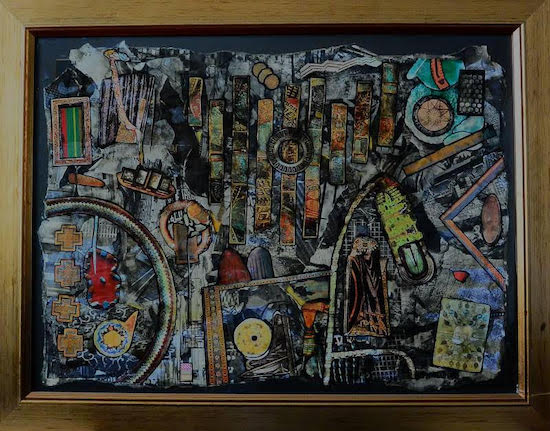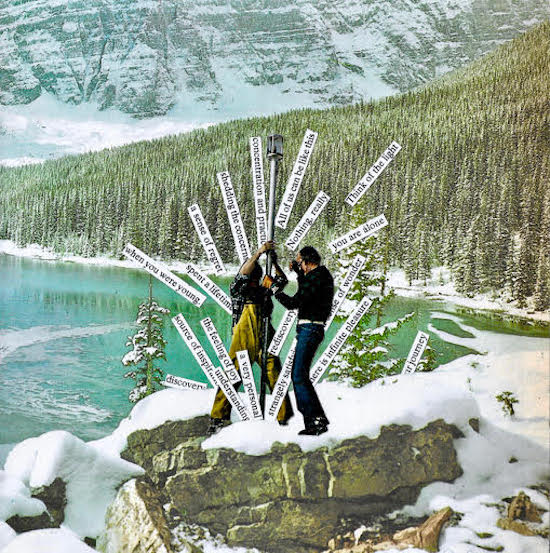Ed Dowie ‘Untitled’
With the complete cessation of performance, collaboration, and exhibition, the past year has had a disastrous impact on the income and creative agency of many musicians and creative practitioners, resulting in the pursuit of alternative channels. Bassist Trevor Dunn’s Instagram account became peppered with photos of collage and collected materials. He turned to the medium during the pandemic when he began hand-making covers for his Bandcamp mixtapes. “It’s a way to be creative in an extremely free way,” says Dunn. “It holds none of the stigma or pressure that I put on myself as a musician, as someone who has studied and worked professionally as such for over thirty-five years. I find the whole process meditative and a bit childlike.” Inspired by the original Surrealists and in particular, Max Ernst, Dunn also takes inspiration from the styles and techniques he sees on Instagram.
British musician Ed Dowie also finds collage a useful way to channel his creativity and has amassed a box of 700 pieces since he first started back in 2012. “It feels immediately graspable,” said Dowie, “very tactile and nowhere near as daunting as something like painting or drawing. It’s a very different experience to making music because I basically don’t know what I’m doing, so I don’t feel too judgemental about what I’m making.”
When Sam Tucker’s booking agency Yuppies Music suffered the impact of the pandemic, he spent a lot of time making his own works, soon learning that his musician friends and clients were also doing the same. “Leafcutter John has always been a real inspiration to me,” says Tucker, “we started posting random bits and bobs to each other, connected through Royal Mail.” Yuppies artists Rachel Dadd and Yoshimo from Yama Warashi had also been making artwork and before long, Tucker had launched the Super Cool Drawing Exhibition. The touring show exhibits work from a variety of musicians who have turned to visual arts including Shabaka Hutchings, Peter Broderick, and Poppy Ackroyd. Some of Ed Dowie’s playful creations will be on display, along with Richard Dawson’s complex and intricate fantasy worlds. “Collage is seeing something, a shape, a colour and imagining its potential, imagining what it could become” says Tucker. And that need not be limited to printed materials, Tucker said that collage can be sculptural, made with found objects, or sonic, as with sound design and plunderphonics.
A sanctuary for those without fine-arts training, collage is accessible and immediate, but there’s a lot more to this liberal medium. Seasoned collage artist Hazel Pitt uses collage as a tool for those suffering with mental health issues. Just as the Surrealists used Freud’s developing theories of psychoanalysis, free association, dream theory and transference to shape their art, Pitt believes that the medium acts as a potent visual conduit for revealing the uncomfortable depths and sometimes frightening shadows of the subconscious mind. She told Kolaj magazine, “With its endless possibilities for humour, joy, fear, absurdity, surreality and more, collage possesses the ability of truly disrupting the senses and is therefore an ideal tool in expressing the sometimes surreal, dream-like qualities of the mind.”

‘Tomb of the Wizard’ by Richard Dawson
Collage as we know it (cut and pasted images) has been around since paper was invented, and there’s debate about when exactly it became a fine arts practice. Originating from the French word ‘coller’ which means to glue or stick together, it’s widely accepted that Picasso and Braque ‘invented’ paper and paint collage, and Hannah Höch is one of the originators of photo-montage (which includes photos and print media). You could say it became a tool for social, political and cultural commentary in the early twentieth century with the work of the Cubists, Surrealists, Dadaists, and Situationists. Editor of Kolaj, the quarterly print magazine devoted to the review and appraisal of the international collage scene, Ric Kasini Kadour believes that while it’s often trivialised and snubbed, collage has always been there in the undercurrent of the art world, thriving mostly outside of academic traditions. “If we look at what some people refer to as ‘Folk Art’” says Kadour, “you’ll see an enormous amount of collage in there. Human beings make art with the things around them. That’s what they do. When you pick up the things around you and put them together, that’s collage.” Rejecting the idea of a singular canon, Kadour believes that the notion is market-driven, ignoring the organic and meaningful evolution of art history and unfairly favouring the European traditions of painting and sculpture.
In recent years however, collage from outside of the Western fine-arts canon has become more prominent with pieces exhibited at the Vancouver Art Gallery, the Tate, the Museum of Modern Art and the National Galleries of Scotland curating ‘Cut and Paste: 400 Years of Collage’ which mapped the history of collage by exhibiting the works of Höch, Ernst and Picasso alongside less celebrated collage artists like Natalia Goncharova and Annegret Soltau. High end fashion brands Kenzo and Prada have used collage in their branding campaigns and it’s become a widely used design feature in magazines and websites with artists like Cold War Steve whose work has appeared in The Guardian, The Big Issue, and the front cover of Time.
Kadour feels that collage plays a fundamental role in the creation of new ideas not only in art but society. The appropriating nature of collage lends itself to the progressive frontiers of digital design where NFTs often incorporate elements of collage. When it comes to cultural diversity Kadour sees a wonderful array of styles coming in from around the world; Victorian-style scrapbooking designs coming from the US Appalachian region, whereas Spanish artists tend to embrace contemporary compositions. Afrofuturist aesthetics have been picked up by artists in Kenya, Nigeria, and South Africa, with digital collage providing a powerful medium for these African artists to visualise speculative post-colonial futures.

By Lara C. Cory
Collage continues to connect worlds and ideas. Thanks to the internet, what used to be called mail art now happens on platforms like Instagram, where artists are forming communities, sharing ideas and strengthening the movement. Events like the annual Februllage, founded in 2019 by Rhed Fawell and Miss Printed, provide a platform for the creation and display of both paper and digital collage. What began with five translations of the prompting calendar, has now grown to twelve different languages from Arabic to Indonesian. While Februllage technically runs only for the month of February, the account is updated all year to help showcase work and forge a larger collage community by sharing open calls and opportunities from collectives and groups from all over the world including Redcollage in Chile, Paris Collage Collective, The Scandinavian Collage Museum, Arizona Collage Collective, Birmingham Collage collective, The Collage Club, Collage Sanctuaries, and Russian_collage.
Fawell says, “collage is easily misunderstood, often perceived as a hobbyist activity, partly due to its democratic nature, but it’s a complex medium offering a diversity of techniques.” She believes that it’s an art form that continues to expand to suit contemporary society, offering a multitude of ways to participate. “Whether through analogue, digital or site-specific projects, it allows individuals to engage on their own terms.”
Initiated by Kolaj Magazine in 2018, World Collage Day takes place on the 8th of this month, to be celebrated by arts communities and creators from all over the world. For more info check out the Kolaj website



